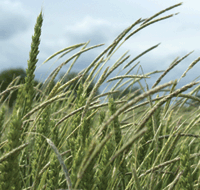Grassweed control on Hampshire farm requires more than herbicides

Herbicides alone cannot keep on top of grassweeds – they need all the help they can get from other measures, Andrew Blake hears on a Hampshire farm
Matthew Culley faces challenges from both blackgrass and brome on the 680ha (1680 acres) of shallow chalky loam and clay cap that he crops around Lone Barn Farm, St Mary Bourne.
The land, mostly contract-farmed, once grew mainly winter and spring barley, but doing so became both economically and agronomically unsustainable.
Now, a rotation of oilseed rape, wheat and spring barley, together with minimal cultivations and careful use of stale seed-beds and herbicides under the guidance of Frontier agronomist Stephen Wood, is proving profitable despite the relatively low-yielding soils.
The two men are even prepared to fallow land for a season to stay ahead of grassweeds. In the long term the practice pays, they believe. “It’s better than struggling on and spending an awful lot extra on chemicals,” says Mr Culley.
“We had a serious brome problem in a couple of fields. We cleaned them up in just a year, and since then we’ve seen a real difference.”
He is ready to rogue blackgrass in summer if necessary and sacrificially spray off brome patches within crops. Most fields have 2m wide sterile margins.

However, it was his move to min-till eight years ago that has proved the real breakthrough. Prompted initially by the high cost of ploughing the flinty land, it has clearly helped wind down grassweed populations.
“It took me four years to find the right machine for our land. But now we’re into the fourth season with our 4m Vaderstad Topdown we can really see the benefits. Now we don’t plough anything – even where we have serious grassweeds. Minimum tillage has transformed our land.”
Weed control effectively starts with the combine. “You’ve got to set it properly for min-tilling.” To that end he has a specific oilseed rape table to help reduce the numbers of volunteers ahead of the following wheat.
Growers without such equipment often have volunteers shading out blackgrass plants they intend to spray off in stale seed-beds, notes Mr Wood. “You really have to take into account every operation, and you can’t afford to consider anything in isolation.”
Judicious use of Roundup on stale seed-beds, twice if need be and if time permits, helps ease the pressure on in-crop herbicides. Last year, despite relatively thin uncompetitive crops and the difficulty of timing sprays correctly, Crystal and IPU, followed by Atlantis in the spring, provided acceptable control of both blackgrass and brome in wheat. “Not all the farm needed Crystal, but with IPU gone I expect to use more this autumn,” says Mr Culley.
Winter oilseed rape always receives Kerb even if there seems no particular blackgrass threat. “We can’t afford to leave any to develop and seed under the canopy,” explains Mr Wood.
Recognising the importance of timely autumn herbicide treatments Mr Culley recently spent £20,000 on a 1993 Caterpillar tractor to haul the Topdown. “We have to be kitted up for the worst scenario.” The move will bring flexibility allowing his other two main tractors to take care of the drilling and spraying, he explains.
He also plans to have most of the wheat Deter-dressed against aphids. Removing the need to wait to spray the pests in one double-hit pass should allow the Crystal to be applied earlier for better effect, he believes.
BETTER STALE SEED-BEDS NEEDED
A Monsanto survey last year found most growers expected autumn weed control to become more challenging; and better post-harvest stale seed-bed practice was high on their list of plans in response, especially among min-tillers.
A stale seed-bed can provide sufficient weed growth in 14 days, but ideally growers should allow four weeks to do the job properly, says the firm’s Robert Plaice.
This season’s low blackgrass dormancy should, in theory, work in their favour. “It potentially provides a very good opportunity to take out more seedlings before drilling.”
However, last season’s low dormancy will have increased the overall seed bank to tackle, so more than one cultivation and Roundup treatment could be needed. “The quality of stale seed-beds is important.” he adds. “Too many growers work their land too deeply. The aim should be to leave the weed seeds in the top 2in, in a well consolidated zone to encourage germination.”
Deeper work to repair soil structure should be kept separate, advises Mr Plaice.
Growers must do all they can to ease the pressure on Atlantis, including taking out resistant blackgrass before sowing and by applying early autumn herbicides correctly, urges BASF’s Clare Tucker. “You must try to make time for stale seed-beds.
“With trifluralin gone, Crystal, with its two complementary actives provides both persistence and combined uptake by both roots and emerging shoots of the weed – it offers growers an excellent base for blackgrass control.”
It should be targeted pre-emergence of the crop where possible. With care added Roundup could help out on any weeds emerging immediately before the crop, says Mrs Tucker.
However, more emphasis on getting the herbicide on before crop emergence requires more attention to seed-beds and drilling depth, she notes. “Seed should be drilled at least 3cm deep and seed-beds rolled before spraying.
“Our trials last year investigated a number of combinations of products to improve control still further on sites where blackgrass pressure is severe. Crystal + DFF was one of the best.”
Product active ingredient
- Atlantis iodosulfuron + mesosulfuron
- Crystal flufenicet + pendimethalin
- Deter clothianidin
- DFF diflufenican
- Kerb propyzamide
- Roundup glyphosate

